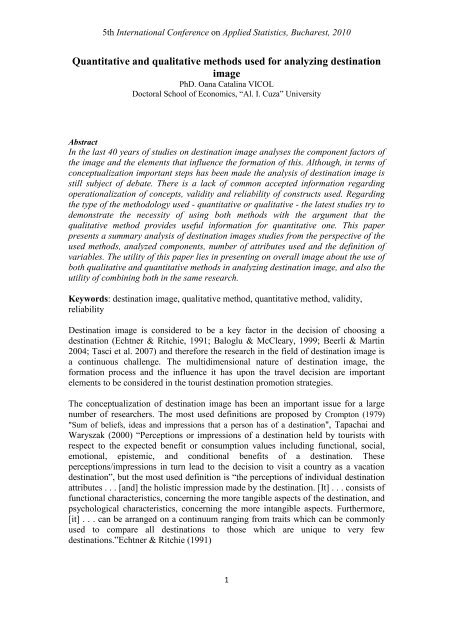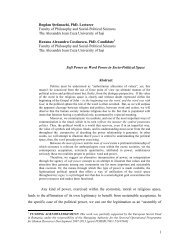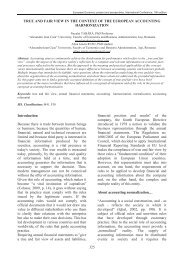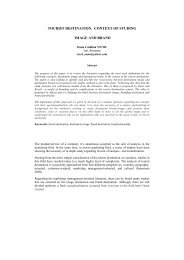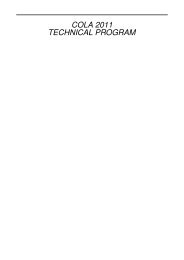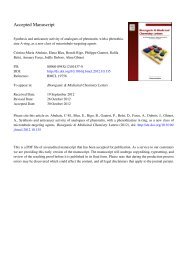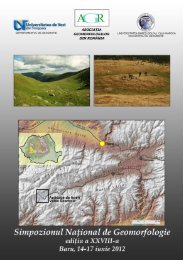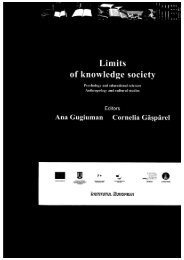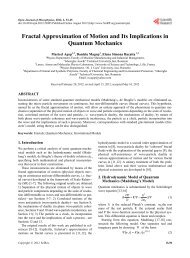Quantitative and qualitative methods used for analyzing destination ...
Quantitative and qualitative methods used for analyzing destination ...
Quantitative and qualitative methods used for analyzing destination ...
Create successful ePaper yourself
Turn your PDF publications into a flip-book with our unique Google optimized e-Paper software.
5th International Conference on Applied Statistics, Bucharest, 2010If the external validity is not realized the results can’t be generalized <strong>and</strong> the researchvalue of low.The next step is selecting the main components from the list of attributes <strong>used</strong> in thequestioner. The factors signification criteria is 0,45 (Hair et al., 1998) <strong>for</strong> a sample of150. After the factor analysis, the number of factors to be <strong>used</strong> <strong>for</strong>ward will bedetermined. Next, the degree of explication of chosen factors in the total variance <strong>and</strong>the trust coefficients (Cronbach Alpha) will be verified, with wised values over 0,7.This test sets the validity of the <strong>destination</strong> image construct.The image <strong>destination</strong> criteria validity will be tested with the regression analysis(OSL). The result factors will be considered independent variables <strong>and</strong> overall imagethe dependent variable.<strong>Quantitative</strong> <strong>and</strong> <strong>qualitative</strong> <strong>methods</strong> in <strong>destination</strong> image researchGlobally, the researches realized on image <strong>destination</strong> have <strong>used</strong> <strong>and</strong> developeddifferent scales <strong>and</strong> instruments <strong>for</strong> measure: in-depth interview, content analysis oftouristic brochures, experts in<strong>for</strong>mation, focus group <strong>and</strong> pilot test <strong>for</strong> scales validity<strong>and</strong> reliability. Scales internal consistency is verified with the Cronbach α test in themajority of published research.In contrast, in <strong>qualitative</strong> approaches validity needs to be tested with other <strong>methods</strong>.For example Lubbe (1998) <strong>used</strong> intraindividual measures <strong>for</strong> reliability testing. Theelements that need to be considered in the <strong>qualitative</strong> research are the factors thatdetermine the instability of answers: respondents’ familiarity with the instrument orits content, fatigue, <strong>and</strong>/or desire <strong>for</strong> cognitive consistency is mostly overlooked.Considering that <strong>destination</strong> image structure is modified depending on theconceptualization, the measurement <strong>and</strong> the techniques <strong>used</strong> differ from a researcherto another. As it can be seen in the table1 most studies <strong>used</strong> the quantitative method,few ones the <strong>qualitative</strong> method <strong>and</strong> fewer combined both <strong>methods</strong>. Majority areusing multivariate <strong>and</strong> bivariate structure techniques.The usefulness of <strong>qualitative</strong> method has been recognized in the last years ascompletion required that reveal psychological characteristics <strong>and</strong> overall impressionsthat can’t not be easy determined with quantitative <strong>methods</strong> (Dann, 1996; Echtner &Ritchie, 1993; Mackay & Fesenmaier, 2000; Reilly, 1990).Research limits on <strong>destination</strong> image1. Qualitative studies use in general a small sample because the difficult method ofdata collection (Lubbe,1998)2. Some quantitative research use a small number of samples as well (Baloglu &Brinberg, 1997).4
5th International Conference on Applied Statistics, Bucharest, 2010Young(1999)quantitative<strong>qualitative</strong>imageprevious visitationimagesocio demographics: homecountry, culture, gender,household status, classstructured image usual residenceimageimageimageimageimageimageChen <strong>and</strong> Hsu (2000) quantitative structured desirability of<strong>destination</strong>trip-planning timeframebudgeted travelcostslength of tripBaloglu <strong>and</strong> Mangaloglu quantitative structured <strong>and</strong> image(2001)<strong>qualitative</strong>open-endedimageJoppe, Martin <strong>and</strong>Waalen(2001)quantitative<strong>qualitative</strong>previous place visitationprevious rain<strong>for</strong>est visitationfrequency of holidaying innatural environmentsnumber of days spent in theareastyle of travel (independent orguided)whether brochures were aprimary source of infoimage attributesimage attributesimage attributesimage attributesfamiliaritydemographics: age, gender,education, income, maritalstatusstructured important attributes origin of visitorslevel of satisfaction origin of visitorswith the attributesLeisen (2001) quantitative structured image intention to visitRittchainuwat, Qu <strong>and</strong> quantitative structured likelihood of repeat imageBrown(2001)travelSonmez <strong>and</strong>Sirakaya(2002)quantitative structured likelihood ofchoosing the countryas the next vacation<strong>destination</strong>cognitive, affective, <strong>and</strong>holistic image componentsReferences1. Babbie, E. (2004). The practice of social research (10th ed.). Wadsworth:Thomson.disponibilala:http://books.google.ro/books?id=QySynvetGQIC&printsec=frontcover&dq=The+practice+of+social+research&source=bl&ots=y3ohtgiiUH&sig=CkBn49qPubDUB8ogkvLZB8cs3O0&hl=ro&ei=Dj8jTLOQJJ-HOIqRnZcF&sa=X&oi=book_result&ct=result&resnum=3&ved=0CDIQ6AEwAg#v=onepage&q& =false2. Baloglu, S., & Brinberg, D. (1997). Affective images of tourism <strong>destination</strong>s.Journal of Travel Research, 35(4), 11-15.3. Baloglu, S. (1999). A path analytic model of visitation intention involvingin<strong>for</strong>mation sources, socio-psychological motivadtions, <strong>and</strong> <strong>destination</strong> image.Journal of Travel <strong>and</strong> Tourism Marketing, 8(3), 81–91.4. Baloglu, S., & McCleary, K. W. (1999). U.S. international pleasure travelers’images of four Mediterranean <strong>destination</strong>s: A comparison of visitors <strong>and</strong>nonvisitors. Journal ofTravel Research, 38(2), 144-152.6
5th International Conference on Applied Statistics, Bucharest, 20105. Beerli, M. & Martin, J. D. (2004). Factors influencing <strong>destination</strong> image. Annalsof Tourism Research, Vol. 3(3), 657–6816. Choia, S., Lehtoa, X.Y., Morrisonb, A.M.(2007). Destination image representationon the web: Content analysis of Macau travel related websites. TourismManagement,28, 118–129.7. Crompton, J. L. (1979). An assessment of the image of Mexico as a vacation<strong>destination</strong> <strong>and</strong> the influence of geographical location upon that image. Journal ofTravel Research, 17(4), 18-24. In Tasci, A., Gartner, WC. & Cavusgil, ST. (2007).Conceptualization <strong>and</strong> Operationalization of Destination Image. Journal ofHospitality & Tourism Research, 31(194), 196.8. Dann, G. M. S. (1996). Tourists’ images of a <strong>destination</strong>—An alternative analysis.Journal of Travel <strong>and</strong> Tourism Marketing, 5(1/2), 41-55.9. Echtner, C. & Ritchie, JB (1991). The Meaning <strong>and</strong> Measurement of DestinationImage. The Journal of Tourism Studies, 2(2), 6.10. Govers, R. Go, F.M. & Kumar, K. (2007). Promoting tourism <strong>destination</strong> image.Journal of Travel Research, 46, (1), 15-23.11. Hair, Jr. J. F., Anderson, R. E., Tatham, R. L. & Black, W. C. (1998). Multivariatedata analysis. New Jersey: Prentice-Hall. In Hosany, S., Ekinci, Y. <strong>and</strong> Uysal, M.(2007) “Destination Image <strong>and</strong> Destination Personality” International Journal ofCulture, Tourism <strong>and</strong> Hospitality Research,1(1), 62-81.12. Hosany, S., Ekinci, Y. <strong>and</strong> Uysal, M. (2007) “Destination Image <strong>and</strong> DestinationPersonality” International Journal of Culture, Tourism <strong>and</strong> HospitalityResearch,1(1), 62-8113. Lubbe, B. (1998). Primary image as a dimension of <strong>destination</strong> image: Anempirical assessment. Journal of Travel <strong>and</strong> Tourism Marketing, 7(4), 21-43.14. Martin, H., Bosque, I. R. (2008). Exploring the cognitive-affective nature of<strong>destination</strong> image <strong>and</strong> the role of psychological factors in its <strong>for</strong>mation. TourismManagement 29, 263–27715. MacKay, K. J., & Fesenmaier, D. R. (1997). Pictorial element of <strong>destination</strong> inimage <strong>for</strong>mation. Annals of Tourism Research, 24(3), 537-565.16. Roberts P et al (2006). Reliability <strong>and</strong> validity in research. Nursing St<strong>and</strong>ard. 20(44) 41-4517. Tapachai, N. & Waryszak, R. (2000). An examination of the role of beneficialimage in tourist <strong>destination</strong> selection. Journal of Travel Research, 39, 37-44.18. Tasci, A., Gartner, WC. & Cavusgil, ST. (2007). Conceptualization <strong>and</strong>Operationalization of Destination Image. Journal of Hospitality & TourismResearch, 31(194), 196.7
Copyright of 5th International Conference on Applied Statistics is the property of Bucharest Academy ofEconomic Studies & National Institute of Statistics <strong>and</strong> its content may not be copied or emailed to multiplesites or posted to a listserv without the copyright holder's express written permission. However, users may print,download, or email articles <strong>for</strong> individual use.


